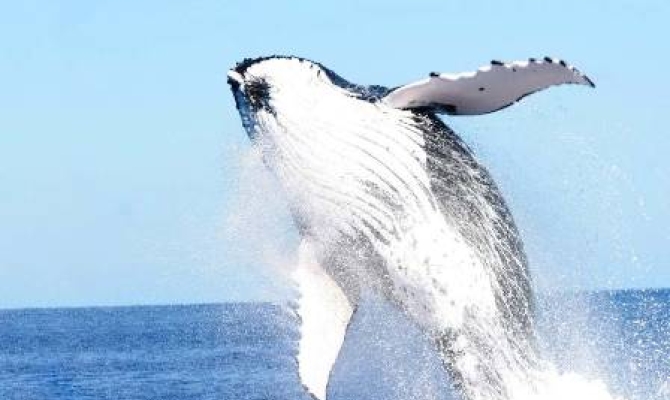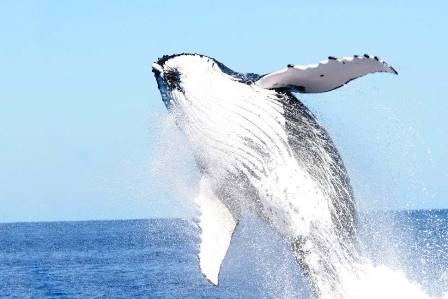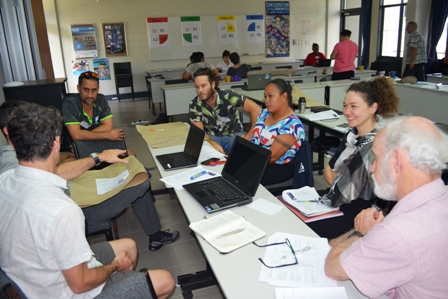
Island and Ocean Ecosystems
19 September 2015, Apia, Samoa - The Pacific islands are uniting to strengthen Whale Conservation through a specially designed campaign that starts next year. Pacific island governments and partners came together to continue the planning and preparation of this special campaign in Apia, Samoa today.
The three key elements for the special campaign encompass Science, Conservation Management Planning and Education Material to help enhance Whale Conservation.
 Humpback whale in Vava'u, Tonga. Photo courtesy of Micheal Donoghue
Humpback whale in Vava'u, Tonga. Photo courtesy of Micheal Donoghue
The Scientific Committee of the International Whaling Commission (IWC) notes that between 1900 and 1965 industrial fleets killed over two million large whales on their summer feeding grounds. By 1965 the population of humpback whales in Oceania was reduced from more than 14,000 whales to less than 1% of that number.
"Thanks, in no small part to the declaration of some of the world's largest whale sanctuaries by members of the Secretariat of the Pacific Regional Environment Programme (SPREP) that number has now increased to around 5,000 whales, and forms the basis of valuable whale-watch industries in several countries," said Mr. David Sheppard the Director-General of SPREP.
"This is one of the world's most encouraging conservation success stories."
At least 30 different whale and dolphin species are known to migrate or reside within the Economic Exclusive Zones of the 21 Pacific island countries and territory members of SPREP. Species including the largest, the blue whale as well as numerous other baleen whale species like the minke, fin, sei and humpback whale, are present in the Pacific islands region.
In addition, toothed cetaceans of all sizes including false killer whales, short-finned pilot whales and many dolphin species such as pan-tropical spotted, striped and Risso's dolphins occur in the waters of many Pacific island countries and territories.
Whales currently face many other threats including entanglement in fishing gear, ingestion of plastics and other marine debris, pollution, and climate change.
 The ambitious work plan of action amongst the partners and countries to strengthen whale conservation across the Pacific island region was discussed during the one day planning and preparation activity.
The ambitious work plan of action amongst the partners and countries to strengthen whale conservation across the Pacific island region was discussed during the one day planning and preparation activity.
Proposals for action include the promotion of responsible whale watching, a socio economic update of whale watching activities in the Pacific, surveys and impacts of deep-sea mining on cetaceans, strengthening education and outreach, as well as studying the cultural transmission of humpback song in New Caledonia and across the Pacific islands.
"It is only fitting that we should choose the whale as the symbol of hope and optimism for our ocean in the coming years, for whales are the great sentinels," said Mr. Sheppard.
"They reflect the state of the oceans, whether in the amount of pollutants that accumulate in their bodies; or the nets, longlines, ropes and other debris from the fishing and maritime industries that can entangle them."
The Pacific Year of the Whale will be launched in 2016 with an action plan of activities to be completed for evaluation in 2018 to prepare the path forward to continue Whale Conservation activities once the special campaign ends.
The three key elements for the special campaign encompass Science, Conservation Management Planning and Education Material to help enhance Whale Conservation.
 Humpback whale in Vava'u, Tonga. Photo courtesy of Micheal Donoghue
Humpback whale in Vava'u, Tonga. Photo courtesy of Micheal Donoghue"Thanks, in no small part to the declaration of some of the world's largest whale sanctuaries by members of the Secretariat of the Pacific Regional Environment Programme (SPREP) that number has now increased to around 5,000 whales, and forms the basis of valuable whale-watch industries in several countries," said Mr. David Sheppard the Director-General of SPREP.
"This is one of the world's most encouraging conservation success stories."
At least 30 different whale and dolphin species are known to migrate or reside within the Economic Exclusive Zones of the 21 Pacific island countries and territory members of SPREP. Species including the largest, the blue whale as well as numerous other baleen whale species like the minke, fin, sei and humpback whale, are present in the Pacific islands region.
In addition, toothed cetaceans of all sizes including false killer whales, short-finned pilot whales and many dolphin species such as pan-tropical spotted, striped and Risso's dolphins occur in the waters of many Pacific island countries and territories.
Whales currently face many other threats including entanglement in fishing gear, ingestion of plastics and other marine debris, pollution, and climate change.

Proposals for action include the promotion of responsible whale watching, a socio economic update of whale watching activities in the Pacific, surveys and impacts of deep-sea mining on cetaceans, strengthening education and outreach, as well as studying the cultural transmission of humpback song in New Caledonia and across the Pacific islands.
"It is only fitting that we should choose the whale as the symbol of hope and optimism for our ocean in the coming years, for whales are the great sentinels," said Mr. Sheppard.
"They reflect the state of the oceans, whether in the amount of pollutants that accumulate in their bodies; or the nets, longlines, ropes and other debris from the fishing and maritime industries that can entangle them."
The Pacific Year of the Whale will be launched in 2016 with an action plan of activities to be completed for evaluation in 2018 to prepare the path forward to continue Whale Conservation activities once the special campaign ends.